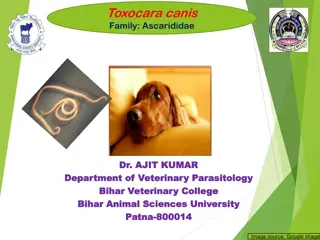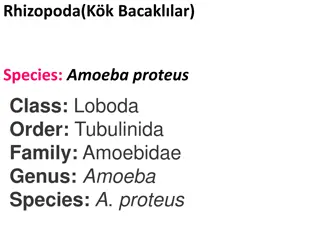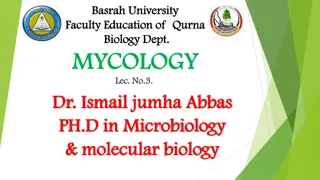Malaria Vaccines 101
Explore the complexities of malaria vaccine development, targeting Plasmodium species/stages, immunity evidence, and broad vaccine approaches focusing on sub-unit vaccines. Discover the quest for an effective and accessible malaria vaccine.
9 views • 32 slides
Overview of Plasmodium falciparum and Plasmodium vivax Malaria Parasites
Plasmodium falciparum is the most significant malaria parasite, responsible for about 50% of cases, with a short incubation period and distinct morphology in blood smears. It causes severe symptoms and complications, affecting various organs. In contrast, Plasmodium vivax is the most common malaria
2 views • 7 slides
Control Internal Parasites In Animals
Parasite infections of goats can lead to improper digestion, reduced feed intake, weight loss, anemia and even death. Shop our safeguard goat dewormer to keep your goats healthy and parasite-free. Send us an email at sales@hubersanimalhealth.com for
0 views • 2 slides
Understanding Ecosystems and Disease Ecology
Explore the diverse types of ecosystems, including autochthonous, anthropurgic, and synanthropic ecosystems, and their impact on disease ecology. Learn about biotopes, biocenosis, ecological mosaics, and ecological interfaces, and discover how infectious diseases can be transmitted across these inte
0 views • 10 slides
Understanding Amphistomosis in Ruminants: Causes, Symptoms, and Diagnosis
Amphistomosis is a disease in ruminants caused by several types of rumen flukes. It leads to productivity losses, weight loss, fertility reduction, and other symptoms. Infection occurs through ingestion of contaminated vegetables and raw meat. The parasite affects the rumen and reticulum of sheep, g
0 views • 8 slides
Understanding Biochemical Mechanisms of Drug Action Against Parasites
Parasitic protozoa cause devastating diseases in humans and animals, and chemotherapy is the primary defense. Drug resistance is a challenge, and prevention is crucial. Modern tools aid in studying genetic and biochemical aspects, targeting the parasite selectively. Drugs act by interfering with spe
1 views • 15 slides
Understanding Synchytrium: Causes and Symptoms in Potatoes
Synchytrium is an obligate parasite causing black wart disease in potatoes. It affects underground parts, leading to cauliflower-like outgrowths on tubers. The fungus exhibits a unicellular structure and releases uniflagellate zoospores for asexual reproduction. Germination of prosorus results in th
0 views • 13 slides
Mechanisms of Immune Evasion by Parasites in Immunoparasitology
Understanding how parasites evade the immune system of their hosts is crucial in the field of immunoparasitology. Parasites have developed various strategies such as anatomical seclusion, antigenic variation, and intracellular living to avoid host immune responses. Examples include Plasmodium within
0 views • 26 slides
Understanding Parasitism in Medical Parasitology by Prof. Dr. Ahmed Ali Mohammed
Prof. Dr. Ahmed Ali Mohammed delves into the intriguing world of parasitism, exploring the complex relationships between parasites and hosts. He explains the various types of relationships in parasitology, such as symbiosis, mutualism, commensalism, and parasitism, shedding light on how parasites in
0 views • 23 slides
Understanding Malaria Parasites and Their Life Cycle
Malaria parasites, including Plasmodium vivax, falciparum, malariae, and ovale, exhibit an alternation of generations phenomenon with a life cycle involving asexual and sexual phases. These parasites require both vertebrate and invertebrate hosts for development, with maturation stages involving gam
0 views • 30 slides
Understanding Parasitic Relationships in Medical Parasitology
Medical Parasitology delves into the intricate relationships between parasites and their hosts, encompassing symbiosis, mutualism, commensalism, and parasitism. The success of a parasite hinges on achieving a delicate balance with its host, avoiding expulsion or harm. Various types of parasites are
0 views • 12 slides
Understanding Host-Parasite Relationship in Microbiology
In microbiology, the host-parasite relationship is crucial for understanding diseases caused by pathogens. This lecture covers definitions of terms like pathogenicity, pathogen, disease, resistance, susceptibility, infection, virulence, and transmissibility. It also delves into the division of host
0 views • 16 slides
Understanding Malaria: Causes, Symptoms, and Prevention
Malaria is an infectious disease caused by the Plasmodium parasite, transmitted through the bite of a female Anopheles mosquito. There are four types of Plasmodium parasites, with Plasmodium falciparum being the most severe. Malaria incidence globally has seen millions of cases with significant mort
9 views • 14 slides
Comprehensive Overview of Toxocara canis Life Cycle and Characteristics
Toxocara canis, also known as the Arrow-headed worm, is a parasite commonly found in dogs, particularly in puppies less than six months old. This article explores the general characteristics, life cycle, transmission routes, and prenatal infections of Toxocara canis. From the appearance of the male
0 views • 12 slides
Overview of Giardia lamblia Parasite and Giardiasis Disease
Giardia lamblia, also known as Giardia intestinalis, is a flagellated parasitic microorganism that causes giardiasis by colonizing the small intestine. It infects humans, cats, dogs, and birds, and is a common parasitic human disease globally. Giardiasis, popularly known as beaver fever, can lead to
0 views • 12 slides
Exploring the Fascinating World of Protozoa and Plasmodium spp.
Dive into the intricate life cycle of Protozoa and Plasmodium spp., with detailed images showcasing stages from sporozoites to gametocytes. Learn about the Ookinete, Oocyst, and Sporozoites, each with unique shapes and characteristics. Explore the transfer stages between mosquitoes and humans, unrav
0 views • 12 slides
Understanding Toxoplasmosis: Causes, Transmission, and Hosts
Toxoplasmosis is caused by the Toxoplasma gondii parasite, with cats being the definitive host. The parasite's life cycle involves both sexual and asexual phases, leading to potential infection in humans and other animals. Transmission can occur through contact with cat feces, ingestion of contamina
0 views • 10 slides
Data Analysis and Experimental Results on Cell Activation, Animal Behavior, and Parasite Infection
The analysis covers research findings on cell activation in T cells, mice weight differences, arachnophobia reactions, cane toad parasite infection rates in different areas of Queensland, and neutrophil responses between KO and WT groups. It includes sample size calculations for statistical power in
0 views • 7 slides
Understanding Parasitic Lifecycles and Evolution in Biology
Explore the intricate world of parasites and their lifecycles, from Protists to Bacteria, understanding how parasitism is a successful survival strategy. Discover the diversity of parasites, their lifecycle complexities, and the importance of multiple hosts in parasite development through examples l
0 views • 6 slides
Understanding Malaria: Causes, Symptoms, and Treatment
Malaria, caused by the Plasmodium parasite and transmitted through the bite of infected mosquitoes, is a major global health concern leading to millions of illnesses and deaths annually. The life cycle of the parasite involves different stages in the human host and the mosquito vector. Effective ant
1 views • 107 slides
Understanding Cyclosporiasis Outbreaks in Georgia: A Comprehensive Overview
Explore the prevalence of Cyclospora outbreaks in Georgia from 2005 to 2015, including historical data, diagnosis methods, demographic insights, and notable past outbreaks linked to foodborne sources. Learn about the parasite Cyclospora cayetanensis, its symptoms, diagnosis challenges, and the cycli
1 views • 21 slides
Understanding Entamoeba Histolytica: A Detailed Overview
Entamoeba Histolytica is a zoonotic protozoan parasite found in the digestive tract of various hosts. It mainly exists in two stages - Trophozoite and Cyst. Trophozoites are characterized by their size, clear ectoplasm, and movement via pseudopodia. Cysts are resistant structures with different cont
1 views • 30 slides
Entamoeba histolytica: Protozoan Parasite in Digestive Tract
Entamoeba histolytica is a zoonotic protozoan parasite found in the digestive tracts of various hosts. It exists in trophozoite and cyst forms, with trophozoites containing erythrocytes and pseudopodia. The cyst stage is characterized by spherical masses discharged by trophozoites and containing chr
0 views • 17 slides
Feline Nematode Infection in Annual Health Visit
Millie, a 4-year-old domestic shorthair cat, was found to have Toxocara cati infection during her routine annual health visit. She was asymptomatic, and the infection was detected through a fecal exam. The treatment plan includes using an FDA-approved drug and recommending a monthly parasite prevent
2 views • 11 slides
Comprehensive Overview of Infectious Diseases and Symbiosis in Academic Setting
This academic course covers a wide array of topics related to infectious diseases, including antibiotic stewardship, bacterial infections, viral diseases like HIV/AIDS, fungal and parasitic infections, and parasite life cycles. Additionally, it delves into the intricacies of symbiosis, exploring com
0 views • 24 slides
Understanding Trypanosomiases: African Sleeping Sickness and Chagas Disease
Trypanosomiases are parasitic diseases caused by Trypanosoma parasites, with African sleeping sickness and Chagas disease being the two main types affecting humans. African sleeping sickness, transmitted by the tsetse fly, can lead to chronic or acute illness and is primarily found in Africa. The di
0 views • 13 slides
Lesson 10 Vocabulary Set B
Explore a set of words from Lesson 10 Vocabulary Set B. Learn the meanings and usage of words such as "bellow," "clutter," "dismantle," "farce," "grueling," "lavish," "morbid," "parasite," and "surplus." Enhance your vocabulary with vivid descriptions and examples provided for each word.
0 views • 11 slides
Exploring Microorganisms: Amoeba, Radiolaria, and Sporozoa
Discover the fascinating world of microorganisms including Amoeba Proteus, Acanthometron Pellucidum, Heliosphaera Echinoides, and Plasmodium Vivax. Explore the unique characteristics and classifications of Rhizopoda, Radiolaria, and Sporozoa through detailed images and descriptions.
0 views • 24 slides
Introduction to Myxomycetes: The Fascinating World of Slim Molds
Myxomycetes, commonly known as slim molds, are unique organisms that live in cool, wet habitats, primarily on wood in forests. They lack hyphae and instead have a plasmodium as their somatic structure. These fascinating organisms exhibit holozoic nutrition and reproduce by means of spores inside spo
0 views • 6 slides
Understanding Parasitology: A Comprehensive Overview
Parasitology is the study of parasites, their hosts, and the interactions between them. This field explores the different aspects of parasitism, including the relationships between parasites and hosts, the classification of major parasite groups like protozoa, helminths, and arthropods, and terms cr
0 views • 16 slides
Understanding the Red Queen Hypothesis and Coevolution in Host-Parasite Interactions
Exploring the Red Queen Hypothesis, which suggests that coevolution between hosts and parasites maintains genetic variation. Through images and descriptions, this content delves into the intricate dynamics of the evolutionary arms race, where constant adaptation is necessary for survival and the mai
0 views • 8 slides
Evaluation of Terminal Sire Breeds for Hair Sheep Production Systems: Year 3 Study
This study evaluates the efficacy of terminal sire breeds in hair sheep production systems to produce high-value market lambs focusing on survivability, growth, and parasite resistance. The research involves purebred Katahdin, Suffolk, and Texel sires, with a particular emphasis on grazing performan
0 views • 27 slides
Livestock Parasite Control: Effective Strategies for Managing Internal Parasites
Implementing strategic deworming practices using anthelmintics is essential to control internal parasites in livestock. Proper timing, targeted treatments, and awareness of coccidia can help prevent health issues and maintain animal well-being in cattle, sheep, and goats.
0 views • 15 slides
Laboratory Diagnosis of Malaria: Methods and Procedures
Methods for diagnosing malaria in laboratory settings involve techniques such as light microscopy and rapid diagnostic tests. Light microscopy is used to prepare blood films, enabling the detection of malaria parasites like Plasmodium falciparum. Rapid diagnostic tests can quickly identify malaria a
0 views • 26 slides
Immune Responses to Leishmania Infections in Eastern Mediterranean Region
Dermal lesions caused by Leishmania donovani complex are rare in the Eastern Mediterranean region. Viscerotropic parasites can cause severe infections, while cutaneous infections are mainly caused by Leishmaniatropica and major complexes. Host immune reactions to different strains of Leishmania have
0 views • 30 slides
Understanding the Complexities of Parasite Life Cycles and Host Interactions
Parasites exhibit diverse life cycles and behaviors, with cycles ranging from domestic to sylvatic environments. Factors influencing parasite diseases include host specificity, immunity, and host-parasite interactions. Parasitism can alter host behavior, impacting ecological dynamics. Immunology pla
0 views • 9 slides
Leucocytozoon: Haemoparasite in Birds from Bihar Animal Sciences University
Leucocytozoon, a haemoparasite found in birds, is studied at Bihar Animal Sciences University under Dr. Ajit Kumar. The parasite's morphology, life cycle, and host interactions are detailed, providing valuable insights into its impact on avian health. The research sheds light on the genus Leucocytoz
0 views • 13 slides
Innovations in Parasite Control for Organic Farming
ProPara is dedicated to optimizing parasite control strategies for organic farms through targeted research and innovative tools. By generating data, evaluating implementation strategies, and collaborating with key stakeholders, ProPara aims to enhance animal health and welfare in organic farming pra
0 views • 19 slides
Impact of Resistance on Parasite Fitness in Quinoline-based Antimalarial Drugs
Resistance cost of fitness studies the impact of drug resistance on pathogens like Plasmodium berghei. Lumefantrine and Piperaquine, used in ACT against malaria, are investigated to understand how resistance affects parasite fitness. The research aims to provide insights into combating drug resistan
0 views • 15 slides
Understanding Giardia: Morphology, Life Cycle, and Pathogenesis
Giardia is a protozoan parasite that causes chronic diarrhea in various hosts, including humans and animals. This parasite has unique morphology with trophozoite and cyst stages. Its life cycle involves direct reproduction through binary fission and transmission through contaminated food or water. G
0 views • 19 slides







































